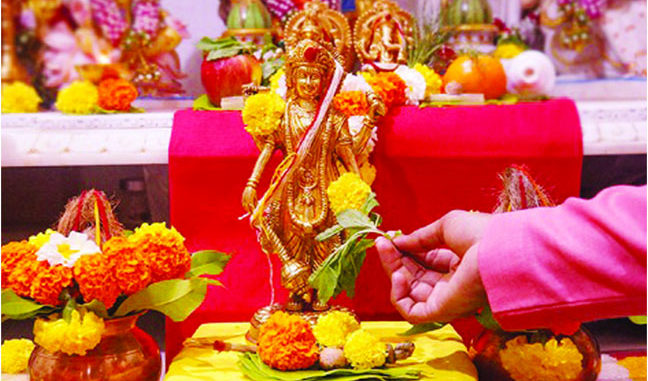
This year, Nirjala Ekadashi falls on Monday, June 21
Nirjala Ekadashi is the most important and significant Ekadashis out of all twenty four Ekadashis in a year. Nirjala means without water and Nirjala Ekadashi fasting is observed without water and any type of food. Nirjala Ekadashi Vratam is the toughest among all Ekadashi fasting due to strict fasting rules. Devotees abstain not only from food but also from water while observing Nirjala Ekadashi Vrat.
This year, Nirjala Ekadashi falls on Monday, June 21, 2021.
Devotees who are unable to observe all twenty fours Ekadashi fasting in a year should observe single Nirjala Ekadashi fasting as fasting on Nirjala Ekadashi brings all benefits of twenty four Ekadashi fasting in a year.
Nirjala Ekadashi is also known as Pandava Ekadashi or Bhimseni Ekadashi or Bhima Ekadashi due to one legend associated with Nirjala Ekadashi. Bhimsen, the second Pandava brother and voracious eater, was not able to control his desire of having food and was not able observe Ekadashi fasting. Except Bhima, all Pandava brothers and Draupadi used to observe all Ekadashi fasting. Bhima, being upset due to his weak determination and doing a dishonor to Lord Vishnu, met Maharishi Vyasa to find some solution. Sage Vyasa advised Bhima to observe single Nirjala Ekadasi fasting to compensate for not observing all Ekadashi fasting in a year. Due to this legend Nirjala Ekadashi is also known as Bhimseni Ekadashi or Pandava Ekadashi.
Parana means breaking the fast. Ekadashi Parana is done after sunrise on next day of Ekadashi fast. It is necessary to do Parana within Dwadashi Tithi unless Dwadashi is over before sunrise. Not doing Parana within Dwadashi is similar to an offence.
Parana should not be done during Hari Vasara. One should wait for Hari Vasara to get over before breaking the fast. Hari Vasara is first one fourth duration of Dwadashi Tithi. The most preferred time to break the fast is Pratahkal. One should avoid breaking the fast during Madhyahna. If due to some reasons one is not able to break the fast during Pratahkal then one should do it after Madhyahna.
At times Ekadashi fasting is suggested on two consecutive days. It is advised that Smartha with family should observe fasting on first day only. The alternate Ekadashi fasting, which is the second one, is suggested for Sanyasis, widows and for those who want Moksha. When alternate Ekadashi fasting is suggested for Smartha it coincides with Vaishnava Ekadashi fasting day.
Ekadashi fasting on both days is suggested for staunch devotees who seek for love and affection of Lord Vishnu.
NIRJALA EKADASHI STORY
The Nirjala Ekadashi vrat Katha or Nirjala Ekadashi story is from the Brahma-Vaivarta Purana. Nirjala Ekadashi vrat ki Katha comes through in a conversation between Bhimasena, better known as Bhima, one of the Pandava brothers of Mahabharata, and the grandson of great Sage Vyasadeva or Sage Veda Vyasa (grandfather of the Pandavas).
Bimasena asks Vyasadeva whether it is possible for His soul to transcend to the spiritual realm even if all the rules of the Ekadashi vrat/fast are not followed strictly. Bhimasena or Bhima was extremely fond of eating and it is said he could eat huge quantities of food. So, in the Nirjala Ekadashi ki Kahani, Bhima tells Vyasadeva that his mother Kunti, his wife Draupadi and his other brothers, i.e. King Yudhistira, Arjuna, Nakula, and Sahadeva observe the Ekadashi fasts meticulously and have many times suggested to him to observe the Ekadashi vrats.
But it was impossible for him to think of fasting for 24hrs; Bhima says that the mere thought of abstaining from eating food is scary and makes him shiver, as he was not able to control his hunger. Bhima says that he can easily do any amount of charity and worship Lord Vishnu with lavish offerings but fasting (vrat) was unthinkable for him.
Bhimasena pleads to his grandfather to tell him of another way to earn the merits of Ekadashi in the easiest way without fasting. On hearing his grandson’s request, Sage Vyasasena tells Bhima about the many merits one can earn on observing Ekadashi fasts strictly and above all get abundantly blessed by Lord Vasudeva. But understanding the plight of his grandson, Sage Vyasasena said that observing only the Nirjala Ekadashi vrat/fast by maintaining a nirjala vrat (dry fast), along with not eating any food would make it possible to earn all the merits equivalent to that earned by observing fast on all the other Ekadashis. He further specifies in the Nirjala Ekadashi Katha that if anyone observes the Nirjala Ekadasi by following all the specified rules and by being completely immersed in chanting the name of Lord Vishnu/Krishna and sings praises of the Lord on the day and throughout the night of Nirjala Ekadashi, that devotee is sure to be liberated and secures a place at the Lotus feet of Lord Vishnu at his eternal abode Vaikuntha. Hearing the Nirjala Ekadashi kahani (story) and benefits of nirjala fasting from the great Sage Vyasasena, the Pandava Prince Bhima was satisfied and agreed to observe at least the Nirjala Ekadashi vrat on the auspicious Nirjala Ekadashi.
NIRJALA EKADASHI VRAT VIDHI
The Nirjala Ekadashi ki vidhi is specified in the ancient Hindu texts and have been specified by Lord Sri Krishna while answering King Yudhishthira’s (the eldest Pandava brothers from Mahabharata) query. The Nirjala Ekadashi benefits are actually innumerable if the nirjala fast/upvas is observed sincerely and with pure intention.
– Observe a waterless fast or Upavas. The fast begins on Ekadasi sunrise and ends on the next day (Dwadasi) Sunrise. However, fasting for two days is not possible for everyone. One may fast on the 1st. June, Tuesday, beginning at Sunrise and ending it between 6:00 AM and 12:04 PM on 2nd June (Wednesday). For advanced devotees, they may fast from 2nd June (Tuesday) onwards until the morning of 3rd. June and the Nirjala Ekadashi fast breaking time is during Nirjala Ekadashi Parana time between 6:03 AM and 8:39 AM.
– Early morning of Nirjala Ekadashi, the devotee should have a bath and should intend on keeping the fast meticulously.
– Perform Achamana but be careful not to put more than just one drop of water to sprinkle in the mouth during Achamana as then the purpose of observing Nirjala Ekadashi is not going to be served.
– You should visit Lord Vishnu/Krishna temple and offer prayers. If a temple is not around, you can worship him at your home in the early morning. The idols of Lord Vishnu should be worshipped with sandalwood, flowers, fruits, lighting pure Cow’s ghee Lamp, and light a dhoop as well. You can worship Lord Vishnu by using energized Vishnu Yantras. Offering delicious Bhog to the Supreme Lord Vishnu is a part of the Nirjala Gyaras/Ekadashi vrat vidhi.
– You can simply meditate on Lord Vishnu and chant His mantra: “Om Namo Bhagavate Vasudevaya”. Sage Narada gave this powerful mantra to Dhruva Maharaja as described in the Bhagavata Purana (4.8.54). You can also chant the Hare Krishna Maha-Mantra on the Tulsi bead.
– You should offer flowers and chant Vishnu Sahasranamam (Thousands name of Lord Vishnu). Chanting a thousand names of Vishnu or Vishnu Stotram has a purifying effect on the mind and the body. You can also play it in the morning while you engage in daily work.
– You should also perform a Vishnu Sahasranama Puja under qualified Brahmins. It is highly recommended on this day. The puja includes Vishnu- Lakshmi Abhishek and Pujan, Vishnu mantra Japa- 1100 times, Vishnu Sahasranama Stotra followed by Homa and Aarti.





Be the first to comment